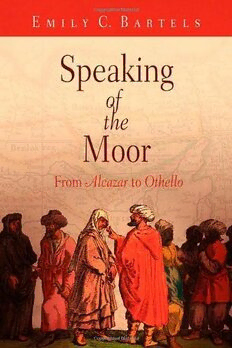
Speaking of the Moor: From "Alcazar" to "Othello" PDF
Preview Speaking of the Moor: From "Alcazar" to "Othello"
Speaking of the Moor This page intentionally left blank Speaking of the Moor From Alcazar to Othello Emily C. Bartels university of pennsylvania press philadelphia Copyright © 2008University of Pennsylvania Press All rights reserved. Except for brief quotations used for purposes of review or scholarly citation, none of this book may be reproduced in any form by any means without written permission from the publisher. Published by University of Pennsylvania Press Philadelphia, Pennsylvania 19104–4112 Printed in the United States of America on acid-free paper 10 9 8 7 6 5 4 3 2 1 A Cataloging-in-Publication record is available from the Library of Congress ISBN978-0-8122-4076-4 For Emma Smith This page intentionally left blank contents introduction On Sitting Down to Read OthelloOnce Again 1 chapter one Enter Barbary: The Battle of Alcazarand “the World” 21 chapter two Imperialist Beginnings: Hakluyt’s Navigationsand the Place and Displacement of Africa 45 chapter three “Incorporate in Rome”: Titus Andronicusand the Consequence of Conquest 65 chapter four Too Many Blackamoors: Deportation, Discrimination, and Elizabeth I 100 chapter five Banishing “all the Moors”: Lust’s Dominionand the Story of Spain 118 chapter six Cultural Traffic: The History and Description of Africa and the Unmooring of the Moor 138 chapter seven The “stranger of here and everywhere”: Othelloand the Moor of Venice 155 viii contents conclusion A Brave New World 191 notes 195 bibliography 227 index 243 acknowledgments 251 introduction On Sitting Down to Read Othello Once Again “Speak of me as I am; nothing extenuate,/Nor aught set down in malice” (Oth. 5.2.341–42).1 This is the instruction that Shakespeare’s “valiant Moor” Othello offers to his audience at the end of the play that bears his name (1.3.48). Yet, as this book—and, I will argue, that play—attempt to show, to speak of Othello, of a “Moor of Venice,” as he is is not as easy or straightfor- ward as it sounds. Othello himself goes on to supply a number of divergent images, each with a different cultural edge. He is, he implies, a proper if erring lover—“one that loved not wisely, but too well,” “one not easily jealous, but being wrought,/Perplexed in the extreme” (5.2.343–45)—and “one” generic or “Venetian” enough that he requires no qualification before the representa- tives of Venice. He is also, however, an “Indian” who “threw a pearl away/ Richer than all his tribe,” and possibly (though less likely) a “Judean” (5.2.346–47).2 His “subdued eyes” become “Arabian trees,” his “tears” their “medicinable gum” (5.2.347–50). All “this,” he orders Lodovico, “set you down” (5.2.350). But “this” is not all. In addition, Lodovico must “say besides that in Aleppo once,” Othello “took by th’ throat” “a malignant and a tur- baned Turk” (who “beat a Venetian and traduced the state”) and “smote him,” just as Othello now stabs himself with an unnoticed weapon (5.2.351–54; em- phasis added). As these images mount up, it is hard to tell whether, where, or how to draw the line between them. Othello’s directive, “set you down this;/And say besides,” which is meaningfully enjambed in the script, at once breaks and bridges the figures that come before and after. It teases us with the illusion of closure and difference—an end to “this” and a start to what “besides”—where
